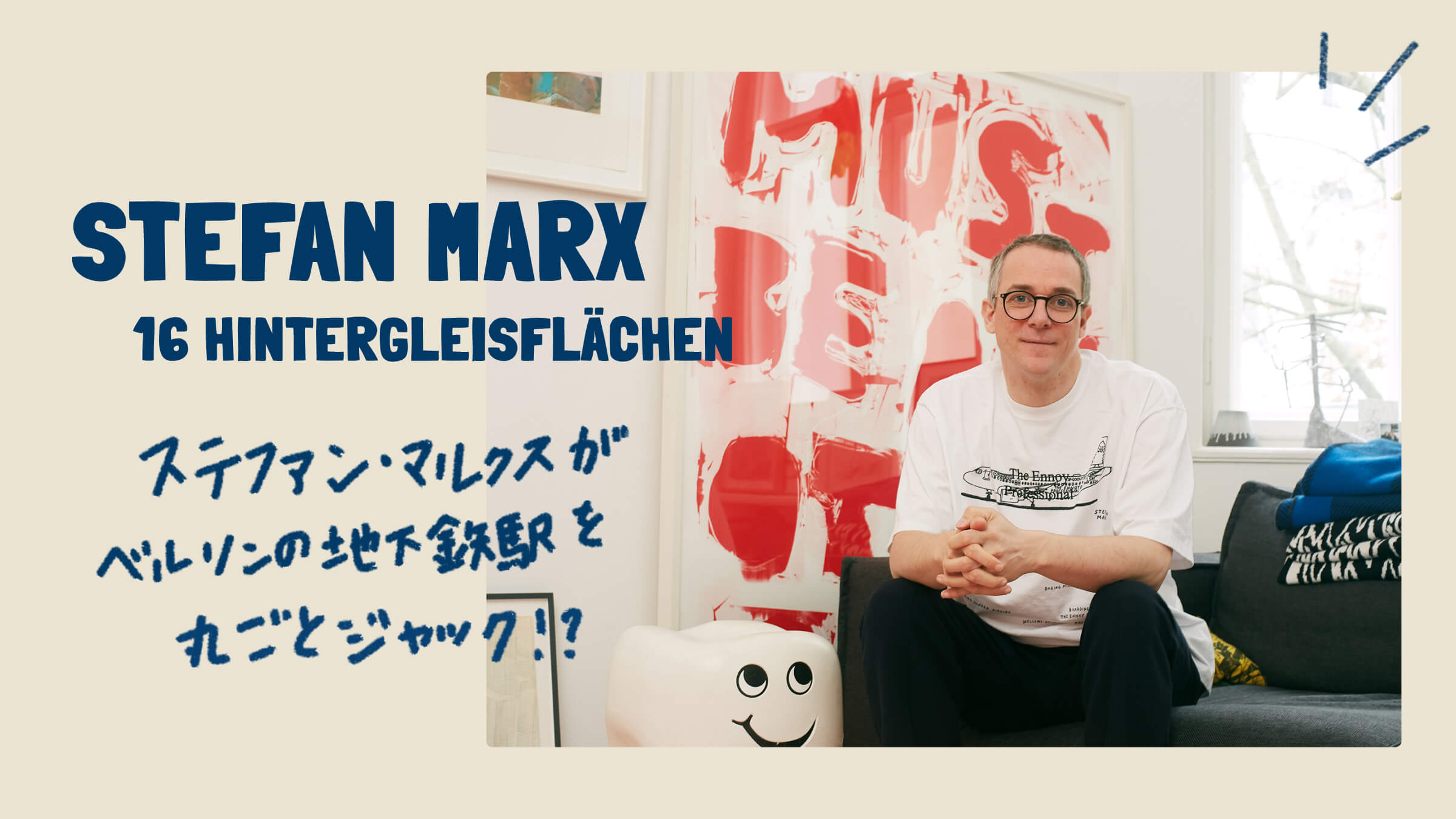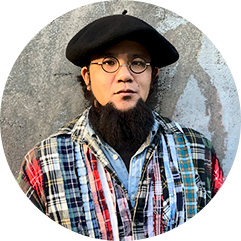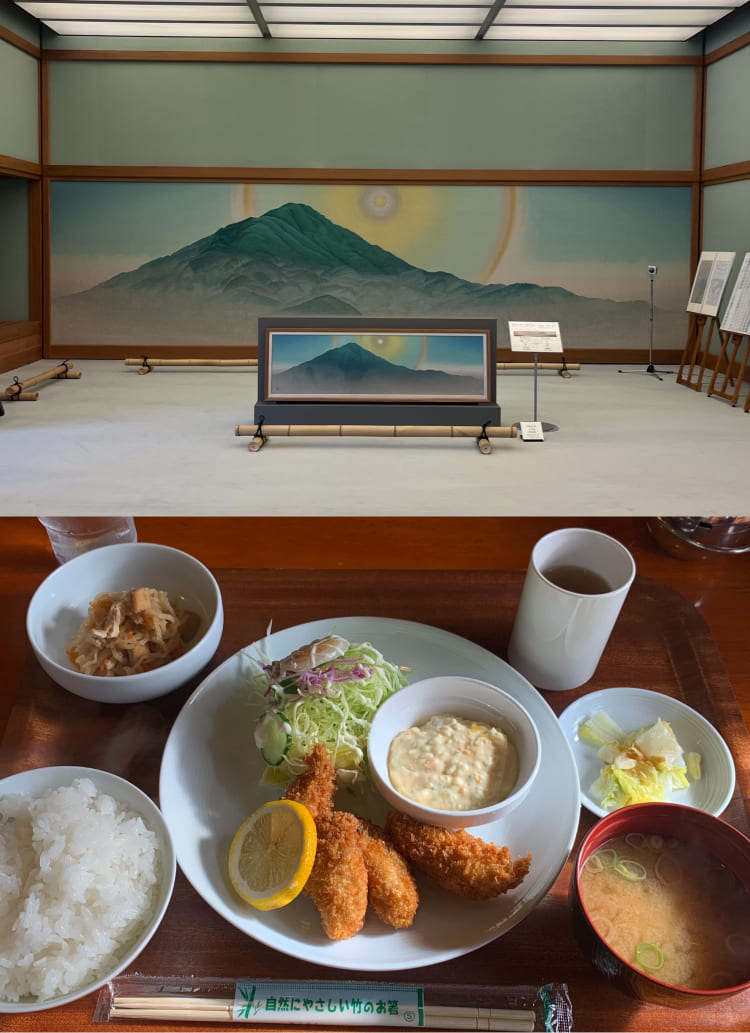
PROFILE
Born in Germany in 1979. Artist and illustrator based in Berlin from Hamburg. Drawing, skateboarding, books, sketchbooks, and other "things he loves" are the source of his activities, and he has demonstrated his talent in a wide range of fields, including publishing collections of his works, art exhibitions, public art, and record jacket design. Through his drawings and paintings, he expresses his worldview, ideology, and indie spirit as a skateboarder, portraying the world from his unique perspective. At the age of 15, he launched his own independent T-shirt label, Lousy Livin'Company, and has been designing T-shirts with high quality and creativity in small production runs. He has also collaborated with many brands and companies on projects ranging from skateboarding brands such as Magenta Skateboards and Five Boro to IKEA. Numerous collections of his work have been published by Nieves, Dashwood Books, and other publishers.
Instagram: @stefanmarx
Berlin is a city that continues to transmit cutting-edge culture while respecting its history.

Stefan Marx "16 Hintergleisflächen
2024, GROTTO Berlin
The city of Berlin has historical backgrounds scattered throughout the city. The subway, called the "U-Bahn (U-Bahn )" in German, is decorated with photographs that chronicle the history of the area, and some stations retain traces of the German version of the Art Nouveau "Jugendstil" style. The platforms have different colors for the walls and fonts for the station signs, and no two are alike. One of Berlin's subway stations with such rich individuality was used entirely for the "16 Hintergleisflächen" exhibition was held in one of Berlin's subway stations. Curated by the art space "GROTTO," the exhibition was held for about a month from January 6 to 31, 2024. The word "Hintergleisflächen" does not exist, but was coined by connecting three German words: Hinter (behind, back), Gles (railroad track), and Flächen (plane).

Stefan Marx "16 Hintergleisflächen
2024, GROTTO Berlin
- You have exhibited your works in various styles in the past, but this is the first time you have attempted to fill an entire station advertisement with your own works. How did you come to hold this exhibition?
Leonie Herweg(Leonie, founder and curator of GROTTO Herweg) is the originator of this project, and I heard about her idea while I was in Japan. She noticed that the station ads on the platform of the Hansaplatz station, which she goes to every day, were empty, and she wanted to do something with them as an art project instead of just putting up ads.
The building where "GROTTO" is located is one of Berlin's most famous mid-century modern buildings, and the neighborhood is similarly famous for its historical architecture, but there were no local companies willing to pay for expensive station advertising. So, BVG ( Berlin Municipal Transportation Authority ) with "16 Hintergleisflächen" was proposed and accepted, and the event was held. Moreover, the station advertisement usually requires a budget of 18,000 euros per month, but because it was an artwork, it could be exhibited for only 2,000 euros.

Stefan Marx "16 Hintergleisflächen
2024, GROTTO Berlin

Stefan Marx "16 Hintergleisflächen
2024, GROTTO Berlin

Stefan Marx "16 Hintergleisflächen
2024, GROTTO Berlin
- This is a wonderful episode that can only happen in Berlin, a city that is generous to the arts. I actually went to see the exhibition and was amazed at the impressive display. What kind of response did you get?
We were surprised by the response, which was much greater than we had imagined. At first we thought it was a small project. Then it was picked up by many major German media, including "Tages Spiegel (Tagesspigel)," and it quickly turned into a big project. We were also able to get coverage from Japanese magazines, like this interview. People who actually went to see and discover the project took pictures and posted them on their Instagram stories, and we were very happy to receive 10 to 20 stories every day.
- Do you plan to sell your work as a book?
No, we did not. 16 posters and postcards of the same drawings were sold for 30 euros per set, and they sold out on the first day. We were able to use all of the proceeds to pay for advertising, so there was no risk at all, and the results were fantastic.

- The 16 posters are written not only in German and English, but also in Ukrainian, Vietnamese, and many other languages, just like the diverse city of Berlin. How did you decide on the languages and messages? Ukrainians who have fled the conflict would be happy to see a station ad in their native language.
Yes, I did. We took excerpts from conversations and lyrics that we normally hear casually and translated them into the languages of various countries. In Ukrainian, it means "I am here to sing a song to you.

Stefan Marx "16 Hintergleisflächen
2024, GROTTO Berlin
-Japanese "Oimasenashimasu." Please tell us why you chose It is very impressive and the Japanese fans are happy with it.
I am also very happy to have been able to make the Japanese language my own. In Japan, when you receive your food or coffee at a restaurant, the staff at the restaurant will say, "O-me-wase-mashimashita," and hand you the goods, right? and then hand over the product, right? I thought that phrase was very impressive and very Japanese, so I decided to use it. I am also interested in katakana, so I use a smartphone app to study it.

Stefan Marx "16 Hintergleisflächen
2024, GROTTO Berlin
The 16 posters were all in white text on a black background, without any advertising-like assertions or promotions. The multitude of languages blended into the everyday life of Berlin, where people of various ethnic backgrounds mix, and delighted the eyes of passersby.
About Japan, which I have visited many times.
- I have visited Japan many times and participated in the "TOKYO ART BOOK FAIR 2023" (hereinafter referred to as TABF) last November. How was it?
It was great! I plan to attend again this year at the end of November.
- At TABF, you shared a table as a tribute to the late Jason Pollan, right?
Yes, I am very happy to have him as a friend. He was my best friend and a colleague who always participated in art book fairs in NY with me. So I was very shocked and saddened by his death, and I still feel that way. I have his original paintings on the wall there, and I have many more of his works. They are very important memories and treasures for me.

The small painting on the back wall was painted by Jason Pollan for Stefan.

- I know that you have a close relationship with Japanese artists. Are there any artists that you are particularly interested in?
Many of the artists we connect with at TABF are HIMAA (Masanao Hirayama), Ken Kagami, Misaki Kawai, and many other Japanese artists. Misaki Kawai once came to Berlin to participate in "Berlin Art Week," you know. I like pink, so I love her works, which are mostly pink-based, and have several in my collection.

Mark Gonzalez's sculpture in the upper right, Misaki Kawai in the lower left, and the pink raincoat hanging is vintage 70's
- Do you also have a skateboard deck? You are a skater, and in the past you have collaborated with Skatehalle Berlin and 5BORO NYC. You have collaborated with Skatehalle Berlin and 5BORO NYC in the past, and you have a deep connection with skate culture. In the video for "Skatehalle In the video for "Skatehalle Berlin," it was impressive to see you sketching while watching skaters skate.
Actually, I don't skateboard anymore. I'm getting too old (laughs). I have so many decks that I can't even put them all here, so I keep them at my parents' house.
His T-shirt label "Lousy Livin" draws inspiration from skate culture and reflects it in its designs. I often receive graphic design requests from skate brands, and I have found myself collaborating with quite a few brands. Each time, I keep an archive of my work, so there are not only decks, but also countless goods, books, and more.

- What is your impression of Japanese skate culture?
The T-shirt I am wearing today is the same as the design of the "5B Airline Series" deck, a collaboration with 5BORO NYC, which was released in 2015 at Gallery We held a release event at Gallery Common in Harajuku in 2015. Many skaters came to the event, and I thought there are many talented and great skaters in Japan. It has its own culture and special charm. The streets of Tokyo are crowded and there is a lot of traffic, so it is nice to skateboard lightly across them.
- You work with many record labels and DJs, do you also draw inspiration from club culture?
Of course it is. I am especially influenced by the club culture in my hometown Hamburg. I like techno and house music, I used to go to parties a lot, and I often work on flyer designs. Among them, my friend Julius Steinhoff(Julius Steinhoff) runs the label Smallville Records", a label run by his friend Julius Steinhoff(Julius Steinhoff), has been designing record jackets, flyers, etc. since its inception in 2012. Recently, I designed the artwork for my friend Peter (Lawrence), also from Hamburg, whose latest album "Gravity Hill" was released on "Smallville Records". I like it very much, along with the sound. This is how I have been working with my friend's artists over the years, and I have developed a deep connection with club culture.
- Lawrence's artwork was a vibrant, beautiful blue with HEAVEN drawings. Smallville Records closed its physical store in 2021, right?
Yes, I know. But I think it was better that way. Running a store and running a label are two completely different things. Julius lives in Freiburg now, and I live in Berlin, so one of the reasons is that neither of us is in Hamburg.
- I first came across your work through the artwork of the Japanese label mule musiq. How did that come about?
Through ATA, I was introduced to Toshiya, the lead designer of "Playhouse" (editor's note: "Playhouse" is a leading German record label established in 1993), as he was also involved in the artwork for the label. (Kawasaki), who is the president of Playhouse, was introduced to me through ATA. He was working at a select store at the time and asked me to design a T-shirt for him. mule musiq" is celebrating its 20th anniversary this year, and my work was used in the announcement video.

- I know you are always busy traveling the world, but what projects do you have planned for this year?
I don't have any big exhibitions planned for this year, but I am thinking of producing a book of my work. Otherwise, I am very busy with many art fairs and artwork commissions in Germany. As I said before, I will be in Japan again in November, so see you at TABF!









